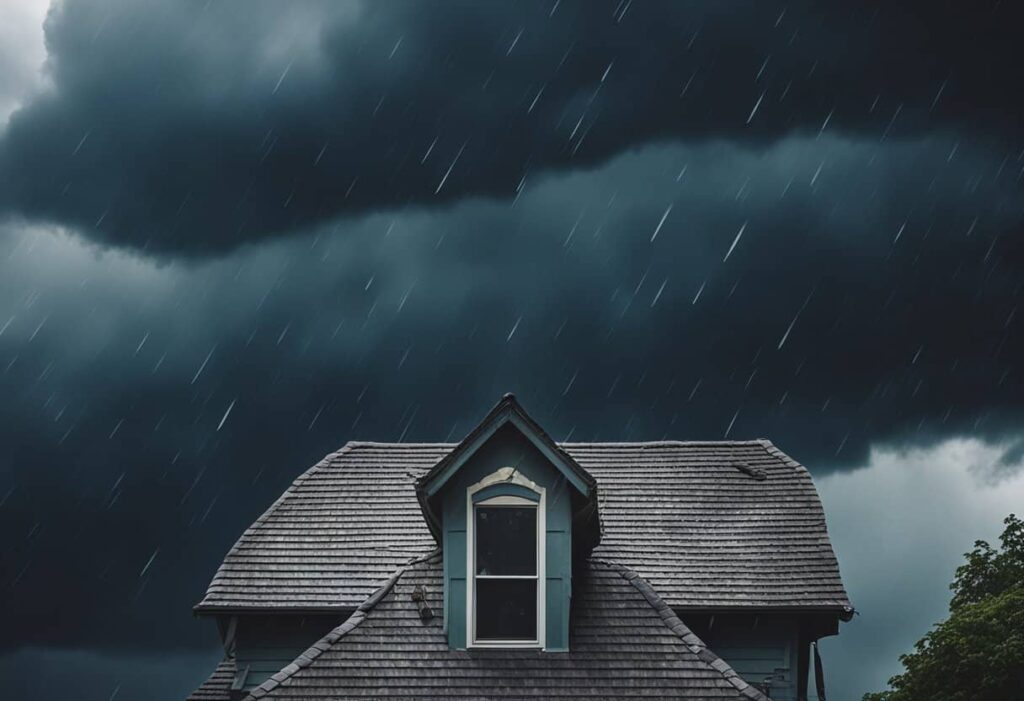Knowing when to replace your roof can save you from costly repairs and headaches down the road. The age of your roof is one of the most crucial indicators that it might be time for a replacement; most roofs last between 20-25 years depending on the materials used and the local weather conditions. Ignoring this can lead to leaks, energy inefficiency, and structural damage.

Signs such as missing shingles, frequent leaks, and visible sagging are red flags that shouldn’t be ignored. Regular maintenance and inspections can help you catch these issues early and address them before they become major problems. Curled or cracked shingles and extensive moss or algae growth can also indicate that your roof’s integrity is compromised.
While some signs are more easily noticeable, others might require a closer inspection. Dark streaks on your roof, for instance, can suggest the presence of moisture. Water damage inside your home, such as stains on ceilings or walls, directly points to roof failure. By being proactive and recognizing these signs early, homeowners can avoid costly repairs and ensure their roofs provide maximum protection.
Recognizing the Warning Signs

Identifying the need for roof replacement is crucial to avoid severe damage and costly repairs. Key indicators include shingle condition, visible water damage, and structural deformation of the roof.
Curling or Missing Shingles
Shingles that curl or are missing entirely are a primary sign of roof wear. Curling occurs when shingles dry out and lose their shape, often due to age or weather exposure. This condition can allow water to seep underneath, leading to leaks and further damage. Missing shingles, on the other hand, leave your roof vulnerable to the elements.
Inspecting shingles regularly is essential. Look for cracks, warping, or any shingles that appear loose or out of place. Replacing them promptly can sometimes extend the life of your roof, but widespread issues often indicate the need for a complete replacement.
Visible Leaks or Water Damage
Water stains on ceilings or walls are a clear sign of roof trouble. Leaks can start small but quickly escalate, causing significant damage to the home’s interior. Check your attic space for signs of moisture, mold, or mildew, which often indicate a problematic roof.
Regular inspections after heavy rainfall can help identify leaks early. If you find damp insulation, water stains, or musty odors, it’s time to consider a roof replacement. Persistent leaks compromise structural integrity, and postponing repairs only increases the potential for extensive damage and higher repair costs.
Sagging or Structural Deformation
A sagging roof is a serious issue that needs immediate attention. This deformation is typically caused by prolonged exposure to water, inadequate support structures, or the weight of accumulated snow and ice. A sound roof should have a uniformly straight appearance; any noticeable sagging suggests underlying problems.
Examining the roof’s alignment from the street or a distance can help detect sagging early. If the roofline looks uneven or dips in places, it signals potential damage to the roof deck or foundational structures. Addressing these signs promptly not only ensures safety but also prevents more severe structural failures.
Age and Lifespan Considerations

Understanding how long different types of roofs typically last and how weather and climate affect their longevity is crucial for timely roof replacement decisions. Knowing when to replace your roof can prevent further damage and costly repairs.
Typical Roof Lifespan
Roofs have varying lifespans depending on their materials. Asphalt shingles, the most common roofing material, generally last 15-30 years. 3-tab asphalt shingles are less durable, typically needing replacement after about 20 years. Meanwhile, architectural asphalt shingles are more robust and can last up to 30 years.
Metal roofs are known for their durability and can last 40-70 years. Tile and slate roofs boast even longer lifespans, often exceeding 50 years. In contrast, wood shingles last around 15-25 years. It’s important to track the age of your roof and look for signs of aging, like curling or missing shingles, to know when to worry about replacement.
Impact of Weather and Climate
Weather and climate significantly impact roof longevity. Regions with extreme weather, such as heavy rainfall, snow, or hail, tend to see faster deterioration in roofing materials. Asphalt shingles may suffer from granule loss, cracking, or discoloration due to prolonged exposure to sun and heat. Metal roofs, while resilient against many conditions, can still suffer from rusting or denting in harsh climates.
Wind and storm damage can shorten the lifespan of most roofing materials. High winds can lift shingles, making them more vulnerable to water damage. In colder climates, the freeze-thaw cycle can cause cracking in tiles or asphalt shingles. Regular maintenance and timely repairs are essential to extend the lifespan of any roof under the stresses of weather and climate.
Periodic Maintenance and Inspections

Conducting regular maintenance and inspections of your roof can significantly increase its lifespan and help to identify minor issues before they become expensive problems.
Importance of Regular Check-Ups
Regular roof inspections are vital for ensuring the long-term durability of your roof. It is recommended that homeowners inspect their roofs at least twice a year, ideally in the spring and fall. These check-ups should include a thorough examination of shingles, flashings, and other roofing materials. Catching issues such as curling or missing shingles, granules in gutters, and minor leaks early can prevent substantial damage and expensive repairs.
Periodic professional inspections are also valuable as experts can spot issues that may not be apparent to an untrained eye. Professionals can assess the overall structural integrity of the roof and offer maintenance advice tailored to your specific type of roofing material.
Identifying Minor Issues Before They Escalate
Spotting minor issues early can save a great deal of time and money in the long run. For instance, water stains on ceilings or walls are early indicators of leaks that require immediate attention before they cause significant water damage. Similarly, finding and removing mold or mildew promptly can prevent health hazards and structural weakening.
Small gaps or cracks in the roof can lead to significant problems if water seeps into the underlying layers. Regular debris removal, such as leaves and twigs, can also prevent moisture retention which can otherwise lead to rot or mold growth.
In addition, maintaining clean gutters and downspouts ensures proper water drainage, which prevents water from backing up under the roofing materials. Regular upkeep of these elements addresses issues at their inception, enhancing the longevity and performance of the roof.
Cost Implications of Roof Replacement
Replacing a roof is a significant investment, influenced by various factors like roof size, materials, and labor costs. It’s essential to weigh the long-term savings of a timely replacement against the immediate repair costs.
Evaluating Repair vs. Replacement Costs
When deciding whether to repair or replace a roof, cost is a critical factor. Repairing minor damage can be more affordable initially, but frequent repairs can add up. Roof Replacement costs are higher upfront but can be more economical in the long run.
Key Factors:
- Roof Size: Larger roofs incur higher costs.
- Materials: Asphalt shingles, metal, and tiles vary in price.
- Labor: Complex roofs require skilled labor, driving up expenses.
A roof replacement in Tampa typically ranges from $5,000 to $25,000, with the average being around $8,000 to $15,000. Smaller roofs and less expensive materials converge toward the lower end of the scale, while larger homes or premium materials drive costs up. Compare this to cumulative repair expenses, which can sometimes exceed the cost of a new roof over time.
Long-Term Savings of Timely Replacement
Timely roof replacement can lead to long-term savings. A new roof enhances energy efficiency, reducing heating and cooling costs. Modern materials offer better insulation, effectively lowering your utility bills.
Benefits:
- Energy Efficiency: Improved insulation reduces energy consumption.
- Home Value: A new roof boosts property value and appeal.
- Reduced Maintenance: Less frequent repairs minimize ongoing costs.
Investing in a roof replacement when signs of wear become evident can prevent more severe damage, such as water leaks or structural issues. Replacing an old or damaged roof promptly ensures better protection for the home, potentially saving thousands in future repair and damage mitigation costs.
Choosing the Right Materials and Contractor
Selecting the appropriate roofing materials and a reliable roofing contractor in Tampa like Rabbit Roofing can ensure the longevity and efficiency of your new roof. Focus on durability, compatibility with your home’s architecture, and the reputation of the professionals you hire. Besides this they will also help in analyzing, which roof is best for your house in Florida.
Selecting Durable Roofing Materials
The choice of roofing material significantly impacts the lifespan and performance of the roof. Asphalt shingles are popular and typically last between 15-30 years. Architectural shingles are more durable and can last over 30 years. Other options include metal roofing, which provides excellent durability and can last up to 50 years, and clay tiles, known for their longevity.
Opt for materials compatible with your home’s climate. For example, metal roofing is beneficial in areas prone to heavy rain and snow due to its durability and resistance to harsh weather conditions. Slate and tile roofing in Tampa are fire-resistant and advantageous in hot climates.
Consider the cost versus longevity and the maintenance requirements of each material. Metal roofing in Tampa might be expensive initially but requires less maintenance over time compared to wood shingles, which need regular treatment for weather-proofing.
Working with Trusted Professionals
Hiring a skilled and trustworthy contractor is crucial for a successful roof replacement. Begin by researching companies with high ratings and positive customer reviews. Verify credentials, such as licenses, insurance, and certifications, like Rabbit Roofing.
Request multiple quotes and compare the services offered. Some contractors may provide additional warranties or maintenance packages, adding value to their services. Ask for references and inspect their previous work to gauge their expertise.
Ensure the contractor’s proposal includes a detailed timeline and cost breakdown. Clear communication regarding project milestones and budget helps prevent misunderstandings and ensures the work aligns with expectations.

